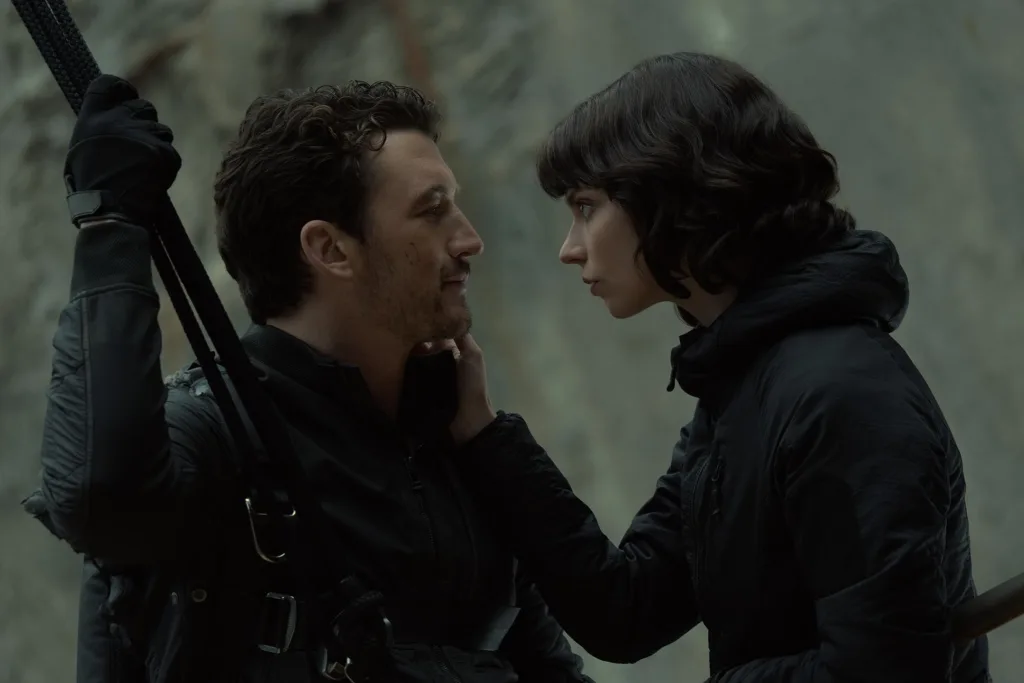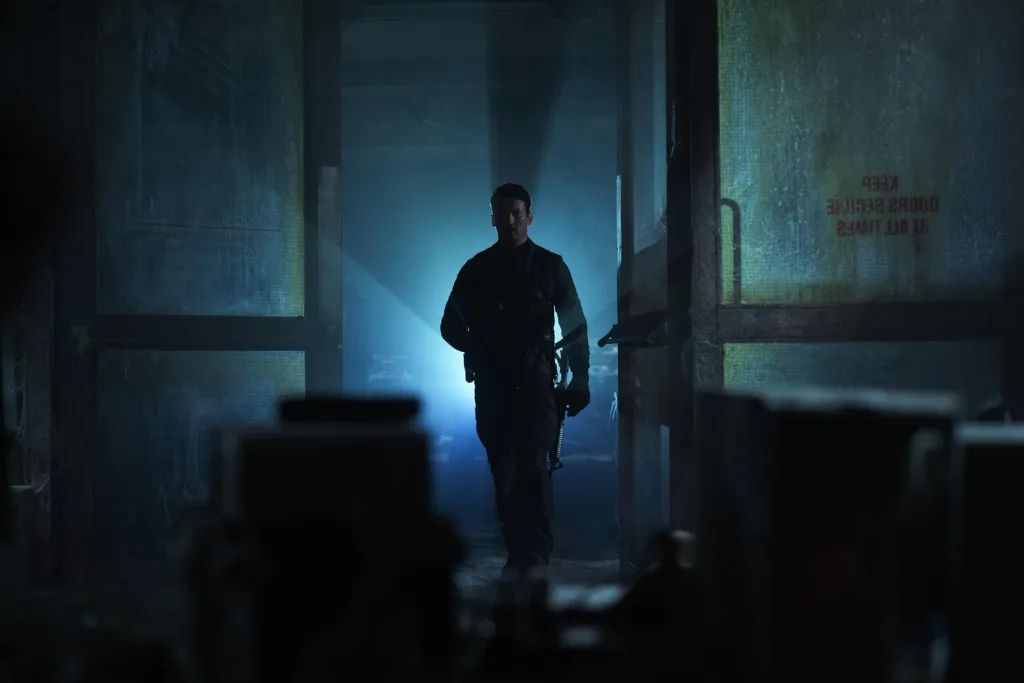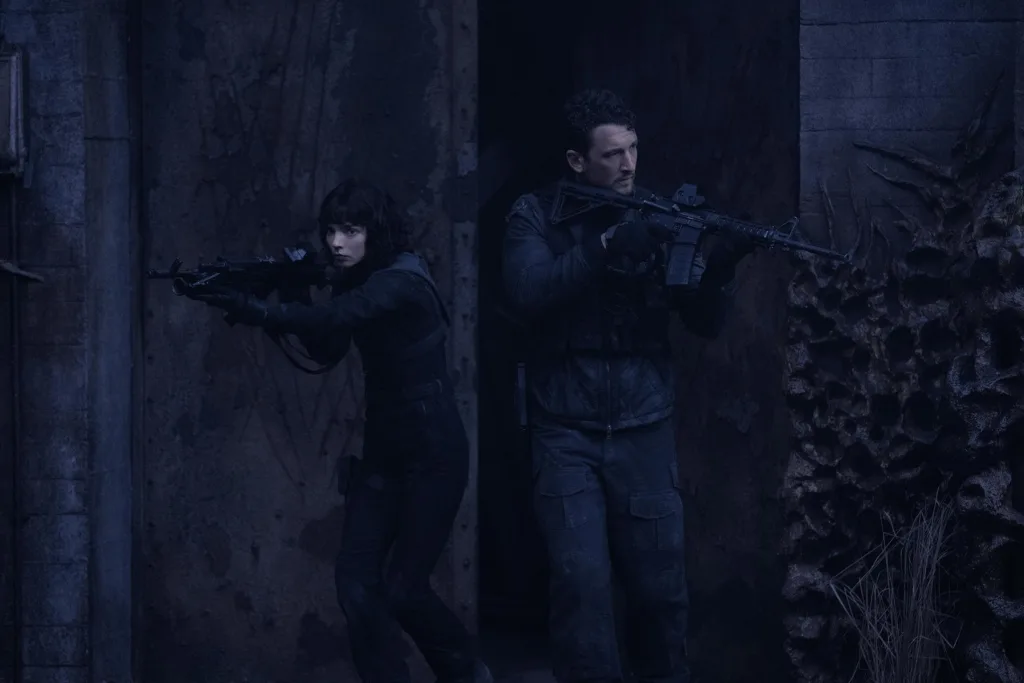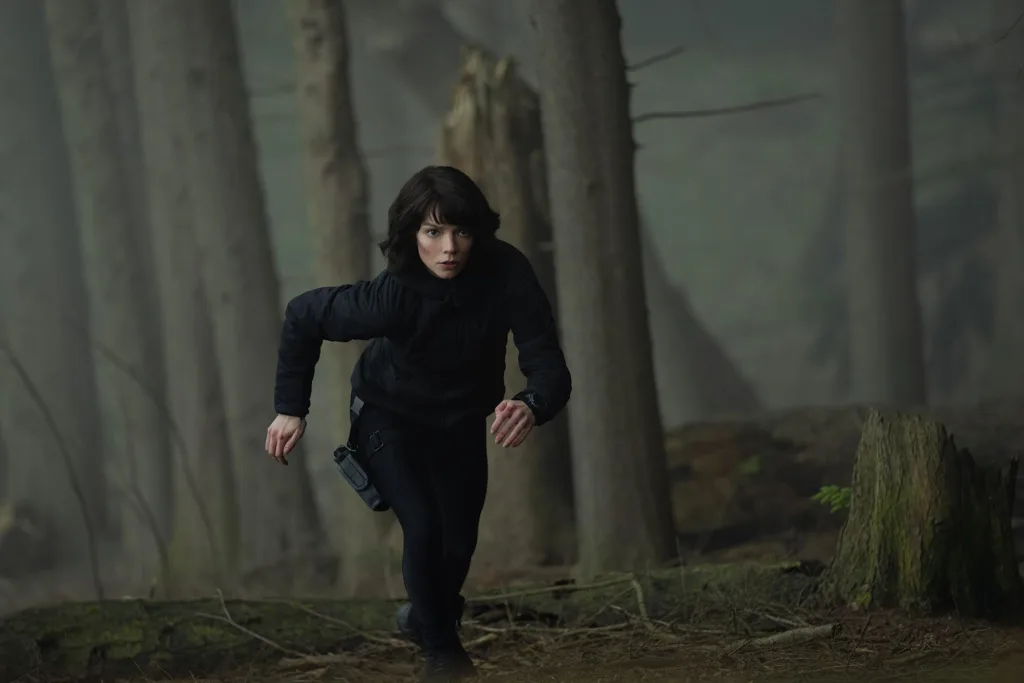In a realm where duty converges with destiny, the film presents us with a pair of elite snipers tasked with the protection of a vast, enigmatic chasm. The narrative intertwines strands of action, science fiction, horror, and romance, crafting a setting that defies easy categorization.
Two figures, hardened by life’s relentless trials, stand apart in the heart of an isolated expanse. Their watchful presence embodies both martial precision and a quiet yearning for connection amid the echoes of their solitude.
The gorge itself emerges as a character, its concrete towers rising starkly against a backdrop of natural wilderness, shrouded in mist and burdened with an unspoken dread. The environment resonates with an almost palpable tension, a muted whisper of untold secrets that beckons the curious and the cautious alike. It hints at realms unseen—a rift that might serve as a gateway to unfathomable terrors.
Here, isolation gives way to an uncanny allure; every stone and every shadow seems to murmur an invitation to peer beyond the veil of ordinary existence. The film thus sets the stage for an exploration of both inner and outer darkness, a vigil that holds the promise of revelations lurking just beneath the surface.
A Descent into the Abyss: Structure and Flow
The film commences by establishing the inner workings of its protagonists, Levi and Drasa, whose pasts are etched in quiet scars and unspoken regrets. Early scenes unfurl a series of measured exchanges and reflective monologues that paint a portrait of men and women scarred by conflict and time.
In a series of sparse, deliberate moments—each line of dialogue and brief glimpse into memory—the narrative paints a picture of lives once intertwined with chaos, now reduced to solitary vigil at a forbidding gorge. This initial exposition is marked by a restrained cadence, as if each word is weighed against the burden of its own existence.
As the narrative advances, a subtle shift occurs. The measured pace of personal revelations gives way to a tension that ripples beneath the surface. Flirtatious exchanges emerge as fleeting respites in an otherwise grim setting, their lightness contrasted sharply with the looming threat that stalks the gorge.
Here, the film introduces an element of disquiet: the slow unraveling of a secret that the landscape itself seems to guard. With every whispered hint and visual cue, the gorge’s hidden nature reveals itself gradually, entwining the characters’ inner struggles with a growing sense of external peril.
Then, the film surges into moments of raw, kinetic energy. Explosive sequences burst forth like violent dreams, their rhythm jarring against the prior, measured tone. In these scenes, the choreography of action mirrors the internal disarray of its guardians.
The pacing, at times erratic, leaves one to ponder whether the frenetic crescendo serves as a catharsis or merely as a prelude to further uncertainty. The interplay of personal scars and the external menace invites a meditation on the fragility of human resolve—a question posed in the space where silence meets the roar of a hidden terror.
Echoes in the Void: The Soul and the Spark
The film introduces us to two solitary figures whose pasts are carved by hardship and conflict. Levi, a man molded by the harsh discipline of military life and the unforgiving world of private contracts, carries within him the silent scars of battle and the haunting weight of unspoken trauma. His nights are often disrupted by recollections that seep into the present like shadows at dusk.
In contrast, Drasa emerges from the mist of her Lithuanian origins, a figure marked by personal losses and internal strife. Her spirit, though bruised, flickers with a restless energy that challenges the cold order of fate. Each accepts the perilous task of guarding a mysterious chasm, driven by motivations that are as enigmatic as the abyss they watch over.
Their meeting is a study in contrasts—a measured stoicism meets a vivacious defiance. Through cautious, handwritten communiqués spanning the dark expanse of the gorge, a delicate conversation begins.
In these transient exchanges, a spark is kindled; the ritual of shared glances and fleeting smiles transcends the clinical nature of their assignment. This connection, though tentative at first, grows into a quiet interdependence, hinting at the possibility that shared isolation may offer solace amid despair.
The narrative also introduces figures who serve as faint echoes of a broader, unseen world. A shadowy superior, portrayed with enigmatic authority, offers moments of stark, almost spectral insight into the forces that drive the operation.
Brief appearances from other characters add nuance, providing fragments of context that hint at a larger, uncharted mystery surrounding the gorge. Each supporting role, fleeting yet significant, contributes to the intricate interplay between human frailty and the overwhelming presence of an indifferent, mysterious void.
Visions of the Abyss: Crafting Light Amid Darkness
The film’s visual realm unfolds like a chiaroscuro painting, where saturated hues—sulfuric yellows, deep purples, and bold reds—coalesce into a mood that mirrors the film’s internal disquiet. The gorge itself is sculpted with an austere elegance: concrete watchtowers rise against the organic chaos of wild terrain, forming a striking contrast between man’s cold constructs and nature’s relentless decay.
Here, the interplay of angular Brutalism and untamed foliage generates a sense of isolation that pulses with latent menace. Atmospheric lighting carves out shadows that creep along the contours of the land, framing each scene in a manner that suggests secrets are hidden in every corner.
Emerging from the depths of this rugged terrain are the “Hollow Men,” spectral figures whose design merges practical ingenuity with digital craftsmanship. Their forms, simultaneously eerie and compelling, lend a weighty sense of realism to the otherworldly threat that lurks beneath the surface.
Practical effects and digital artistry cohabit the screen, offering moments when the uncanny presence of these entities is felt viscerally, each detail echoing the existential dread that underpins the film’s narrative.
Sound, too, assumes a pivotal role in this visual symphony. The score, a creation by Atticus Ross and Trent Reznor, courses through the scenes with a force that punctuates both moments of quiet introspection and bursts of kinetic energy. The sonic textures, marked by deliberate bursts of loud motifs during climactic sequences, weave an aural atmosphere that mirrors the film’s shifting moods.
In certain passages, the sound design acts as an unseen sculptor, molding the environment into an immersive experience that captures both the solitude of the watchtowers and the ominous hum of the gorge. Here, every note and every shadow serves as a reminder of the fragile human spirit set against the vast, indifferent expanse of an enigmatic world.
Discordant Chords in a Shifting Nightscape
The film presents a narrative that exists at the crossroads of many stylistic impulses. It unites the cold discipline of military duty with the eerie tremors of supernatural terror, all while allowing flashes of romance to bloom through handwritten messages and unconventional encounters.
In this composition, the setting—a rugged, isolated chasm—serves as the silent witness to a spectrum of human emotion and dread, its vast emptiness punctuated by moments of unexpected tenderness.
A slow-burning introduction of character backstories gradually gives way to scenes that crackle with kinetic energy. The intensity of combat sequences and the pulsating fear of unseen forces interlace with delicate exchanges that hint at vulnerability. At times, the film oscillates between moods like a record skipping on a forlorn tune. These shifts, abrupt as they are, lend the work an unpredictable rhythm—a stuttering heartbeat that mirrors the fragile psyche of its protagonists.
There is an undercurrent of playful irreverence, a sprinkling of offbeat humor that emerges in whispered banter and sly gestures. Such moments seem to breathe a curious warmth into the otherwise stark tableau of danger and isolation.
They serve as brief respites, offering a counterpoint to the relentless tension that governs the majority of the film’s canvas. Yet, one might wonder if these light-hearted interludes interrupt the narrative’s gravity, or if they enhance its overall texture by exposing the characters’ inner contradictions.
Throughout this odyssey of shifting moods and multifaceted tones, the film challenges its audience with scenes that refuse to settle into a single emotional register. The layering of contrasting styles creates a cinematic experience where every pulse of action and every whispered line carries with it the weight of existential questioning—a murmur in the dark that leaves us pondering the true nature of human resilience in the face of an indifferent void.
Into the Abyss: Thematic Currents and Directorial Vision
At the heart of the film lies an introspective exploration of isolation and the relentless conflict between duty and desire. The narrative examines the personal cost of lives dedicated to conflict, as characters grapple with inner voids and the inevitable erosion of self.
The gorge itself emerges as a potent symbol—a yawning chasm that mirrors both the literal divide between safe haven and threat, and the more abstract fissures within the human spirit. Literary echoes, reminiscent of somber verses, ripple through the dialogue and imagery, hinting at a despair that is as ancient as it is modern.
Scott Derrickson crafts his cinematic vision with a meticulous sense of duality, merging disparate genres into a textured experience that resists simple categorization. His approach infuses the narrative with a raw immediacy that is both timeless and unmistakably current.
The interplay between stark visual contrasts and layered narrative arcs offers a canvas where elements of action, spectral horror, and subdued romance coexist in a state of precarious tension. The film’s aesthetic—its chiaroscuro of light and shadow—reinforces this delicate equilibrium, inviting viewers to question the cost of unwavering duty in a world that too often isolates the soul.
The impact on the viewer is palpable: a stirring of emotions as the film challenges familiar categorizations while probing the existential fissures within its characters. In moments of quiet despair and bursts of frenzied confrontation, one senses the weight of choices made in solitude—a silent reckoning that lingers in the space between what is seen and what remains unspoken.
The Review
The Gorge
The Gorge dares to intertwine conflict, isolation, and fleeting intimacy within a visually compelling yet uneven narrative tapestry. Scott Derrickson's ambitious fusion of action, horror, and romance conjures a cinematic experience that is as challenging as it is thought-provoking, even when its narrative cadence falters. Despite occasional lapses in tone, its bold artistic vision and emotional depth resonate.
PROS
- Visually striking production design
- Bold and experimental genre fusion
- Compelling lead performances
- Evocative, atmospheric score
- Thought-provoking thematic depth
CONS
- Uneven narrative pacing
- Abrupt tonal transitions
- Inconsistent character arcs
- Overreliance on CGI in key sequences




















































